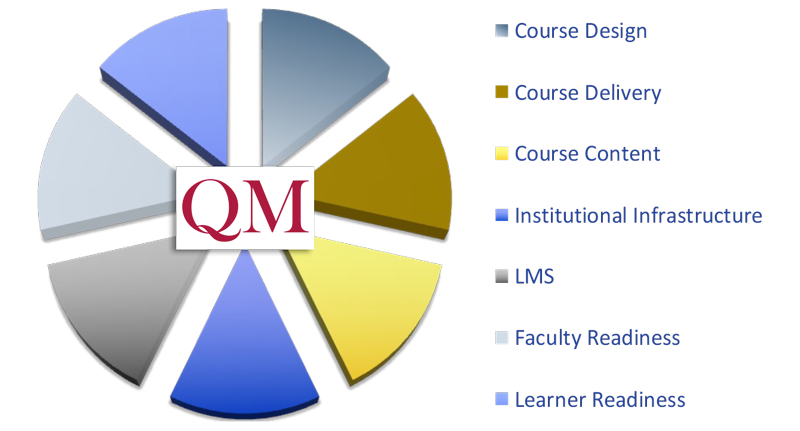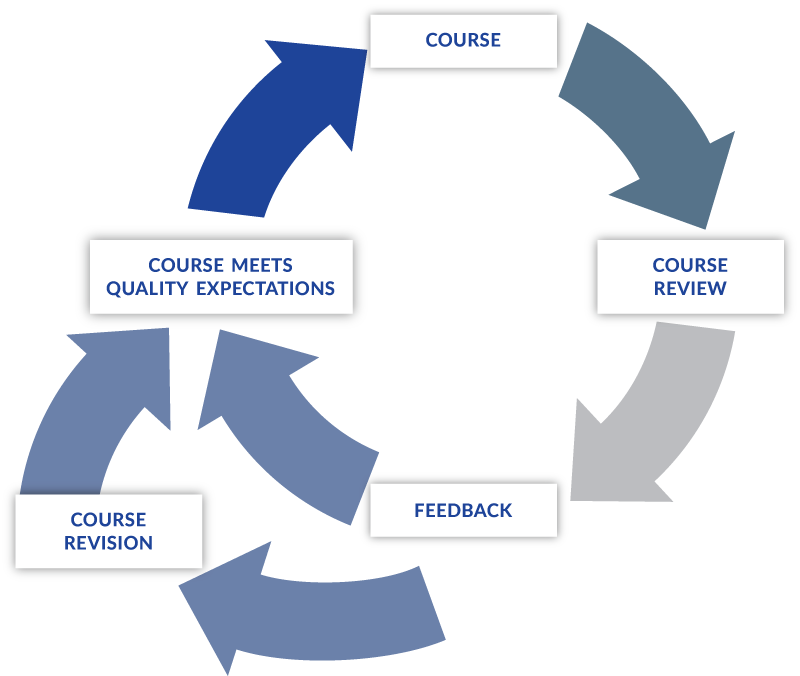
Helping you deliver on your online promise means providing you with a collaborative and collegial process that centers on continuous improvement. This process is designed to help you achieve your quality assurance goals for online learning as they evolve to address all aspects of the Online Learning Quality Pie.
Optimal Implementation of QM
There are many factors that affect the quality of an online course (these are listed in the Online Learning Quality Pie). While the QM model focuses primarily on course design, our members can leverage the QM process — along with QM resources and community members — to scale our model and apply it to all aspects of online learning. But this doesn’t happen overnight. Members usually progress through stages of using QM before they attain an effective implementation within their organization. While each stage can manifest differently depending on the type of organization and its goals, there are typically five stages of implementation* that lead to creating a sustainable quality assurance system that can address all aspects of the Online Learning Quality Pie.
- In this stage, the QM Coordinator is encouraging faculty and staff to familiarize themselves with the QM Rubric, learn how the Standards are structured, and take the Applying the QM Rubric workshop. The goal is to start empowering people to use QM tools, resources, and workbooks to informally review the different components of an online course and evaluate its quality.
- In this stage, members have developed a systematic process to evaluate their courses. The process is consistent and planned according to a schedule that achieves internal quality assurance objectives. Individuals conducting the review have received some QM training in applying the Standards, and some may have received Peer Reviewer certification. The full peer review process is typically not used at this stage. Instead, responsibility for conducting these reviews resides within a single organization unit or committee and the focus is on comparing courses against some or all of the QM Standards to evaluate quality. The organization will have a review schedule in place to ensure that by the end of a given time period — three years for example — every online course goes through an internal committee or individual review that uses QM Standards. At this point, the quality assurance process provides a quality check on the courses, but it’s not considered to be a process that is scalable or replicable beyond the organization
3. Continuous Improvement (CI)
In this stage, members have developed an ongoing, systematic, and scalable review process — though it is still not replicable outside of the organization because it remains customized to the organization. What makes this process a scalable continuous improvement process is the commitment to peer review and the use of the kind of feedback QM prepares reviewers to provide. This review process is built into an organization’s course development or yearly evaluation for improving and creating courses and involves a greater number of people — including faculty who serve as reviewers. In addition, a higher quantity of courses are being reviewed and improved upon. While members may be using MyCR if they have modified the Rubric, many are using QM’s CRMS during internal reviews to get feedback on course quality and prepare for Official Course Reviews.- In this stage, members are using the full QM Rubric and the Official Course Review process to ensure their courses meet QM’s rigorous standards in a way that enables replication across organizations on a national level. Members may be using an official schedule to put all of their courses — or a carefully selected representative sample — through the Official Review process to achieve QM Certification. Courses that are QM Certified are recognized by other organizations as high-quality courses that have met QM Standards for excellence. Achieving this mark shows your organization’s commitment to quality assurance and continuous improvement.
- At this point, the entire organization is fully committed to a comprehensive quality assurance process, has full support from leadership teams, and has integrated the process into long-term, strategic plans. For example, various departments within your organization may have created committees that are dedicated to evaluating and improving the quality of online courses. In addition, faculty and staff that hold QM roles or get courses QM Certified may have been recognized or rewarded for their efforts. By now, the organization has developed appropriate policies that extend the QM model into other key areas of teaching and learning — with QM Program Review, for example — and has committed resources to sustain and grow their quality assurance process.
The QM Course Review Process

Organizations that want to put their courses through an Official Course Review and achieve the QM Certification Mark should ensure they are adequately prepared to make the most of the Course Review process. This involves understanding how the QM Rubric is used to examine course quality and how the review process is used to provide feedback for improving the course. Whether an Official Course Review is managed by QM or the subscriber, all course reviewers must be QM Certified to hold their reviewer role. The composition of the Review Team may differ slightly depending upon the Rubric used. For example, a review team conducted using the Higher Ed Rubric will have a Master Reviewer as the Team Chair and two Peer Reviewers, one of whom is designated as the Subject Matter Expert and one of whom is external to the organization submitting the course for review. A K-12 Review Team will have two reviewers, where at least one is a Subject Matter Expert, and one is a Master Reviewer serving as the Team Chair.
After submitting a course for an Official Course Review, the peer course Review Team will review the course using the QM Rubric and provide feedback on how to improve the quality of the course. Through collaboration with reviewers, instructors, and course developers, QM members can work together to improve the course to meet QM Standards at the 85% quality level or better. Members can also take advantage of professional development options that assist them in using QM Standards to improve courses. While there are many ways to meet QM Standards, a course can only achieve QM Certification once it meets quality expectations.
QM Certification is valid for 3-5 years — depending on the Rubric — and is displayed in learning management systems and course catalogs during this time to communicate course quality to students and other stakeholders. If the course hasn’t undergone substantial changes, it can be re-certified through a shorter review process.
The Role of Research and Data Points
As the QM Community grows and evolves, we learn new things about applying and implementing the QM Rubrics and processes. Therefore, another critical aspect of the QM process is the role our members can play in conducting and contributing to research that is focused on Quality Matters in online learning. As your implementation of QM progresses, we encourage you to capture your experience in qualitative and quantitative data points that can be shared with your organization and the larger QM Community. This sharing of QM — through conference presentations, social media, professional associations, and other collaborations — plays a vital role in moving quality assurance for online learning forward.
*Steps toward excellence model and optimal implementation of QM developed by Deb Adair, 2016
